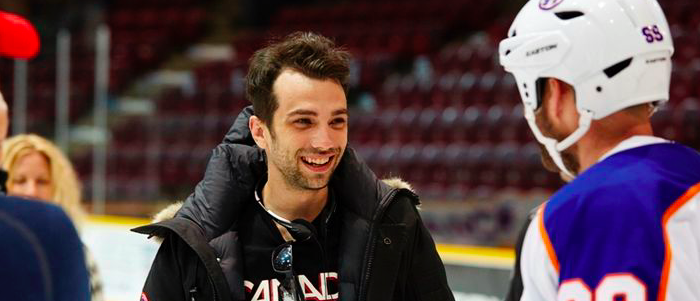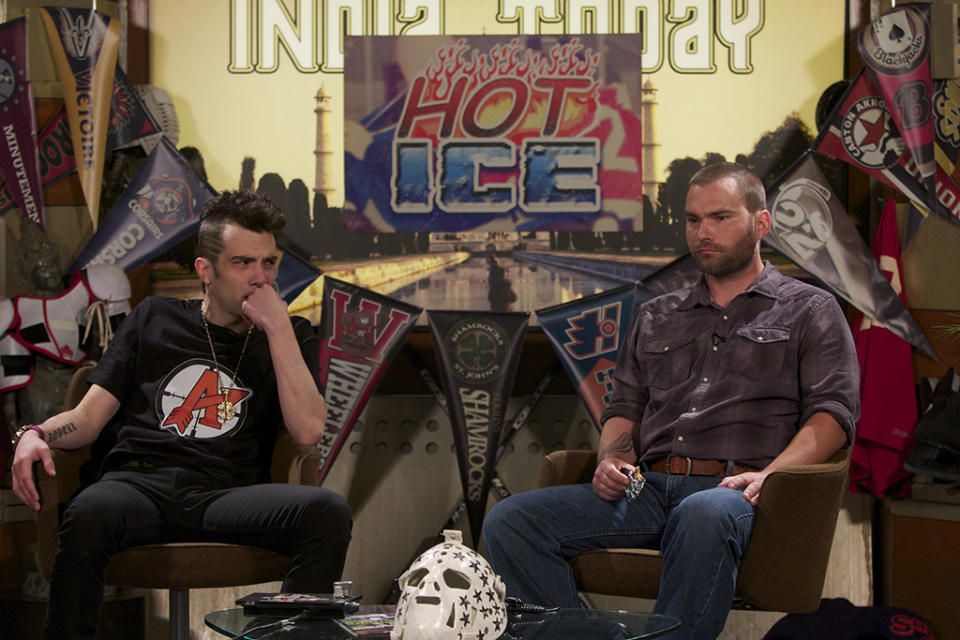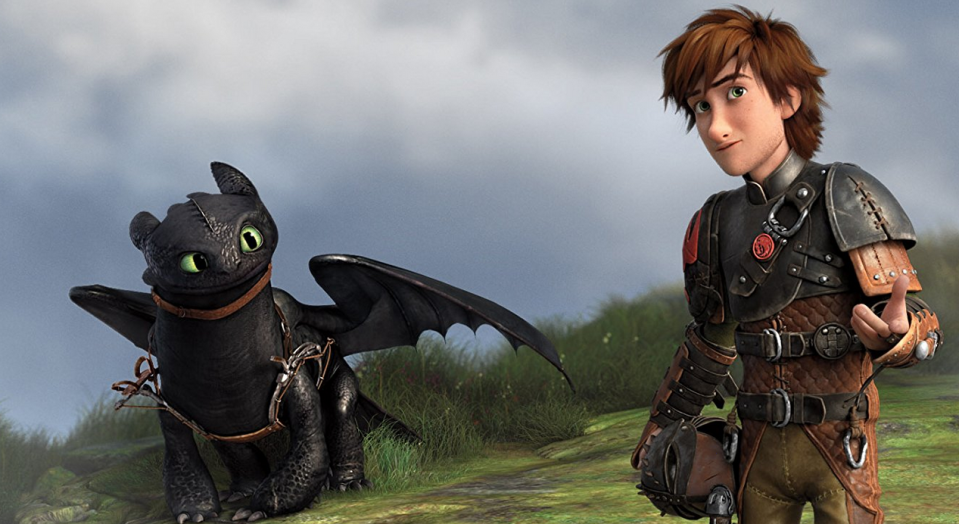Jay Baruchel up for a hat trick after 'Goon 2'? 'We could do this forever'

These days, it’s rare to find a successful mainstream movie that doesn’t have a sequel as part of the initial business plan. But Goon: Last of the Enforcers, the follow-up to 2011’s cult-fave Canadian hockey comedy, is an increasingly rare case where the push to make a sequel came from the filmmakers, rather than accountants.
“We weren’t contractually obligated to deliver a second film,” says Goon mastermind Jay Baruchel, who wrote the original film and steps behind the camera to direct the new one. “We all agreed we were only going to do it if we made it worth it.”
Early reactions suggest that Last of the Enforcers, which premieres in theaters and VOD on Sept. 1 and continues the story of dimwitted on-ice bruiser Doug Glatt (Seann William Scott), was definitely worth it for fans. Baruchel spoke with Yahoo Movies about taking a beloved comedy and making it work again, and whether an entire Goon universe can be built up, just like his hit How to Train Your Dragon franchise.
Your friend and fellow Canadian, Seth Rogen, has expressed reluctance to sequel-ize hit comedies like Superbad. Were you similarly leery about pursuing a Goon follow-up?
I’m sure at some point I was being a precious, artsy a–hole, and said something to that effect. But we did Last of the Enforcers for the most organic reasons possible: we thought there was a conversation we started in the first one, and the next phase of that conversation wouldn’t have had a place in the original. On top of that, there’s something special about Goon. Sometimes a job is everyone doing their best without being certain of the outcome, and sometimes everyone is super-psyched because there’s a unity of vision. When that happens you get a surplus of ideas; you get more stories, more character stuff, and more jokes than you know what to do with, so when the movie’s done, you feel like you’re just scratching the surface. We had other things we wanted to say and it felt like other people wanted to hear us say them, so here we are.
How many versions of the story did you go through?
We always knew what the contents of the film would be thematically. We always knew it would be about age; we always knew it would be evolution vs. extinction; and we always knew it would be about what happens when the thing you’re meant to do is hurting you, so you can’t do it forever. So it was more about the permutations of the story. We took the time, we really did. That said, there were five or six years between the two films, so there are a s–tload of story ideas that didn’t make it into this one.

In your recent WTF with Marc Maron interview, you talked about observing David Cronenberg on the set of Cosmopolis and Clint Eastwood on the set of Million Dollar Baby. Were there specific lessons you learned from those filmmakers that you applied to your own directorial debut?
Definitely. I was struck by how similar a spirit there was to Cosmopolis and Million Dollar Baby: Everyone’s happy to be there, knows what they’re doing, and has confidence in their abilities. You don’t belabor things; it’s a minimum amount of rehearsal and a minimum amount of takes. [Directing] doesn’t have to be about masochism. You don’t have to do 70 takes trying to find the moment. I kind of believe that if you do that, it’s because you don’t know what it is you’re looking for. If you know what the scene’s about, what the movie’s about, and if you get the right people together, you’re there.
I coupled that with some of the other processes I’ve been a part of with Judd [Apatow] and Ben [Stiller] where they kind of let everyone be open. I extended that beyond the cast to the entire crew. My crew would pitch set-ups to me, and I don’t see that on a lot of other sets. They would take initiative; when we were doing all our hockey stuff, we had to take a 20-minute break three times a day to let the Zamboni clean the ice we’d f—-d up. The crew didn’t love that, because we worked very fast and we were proud of our helter-skelter, Hong Kong cinema approach to shooting. So one day, I came in from having a smoke during one of these breaks and my crew had put a camera on the ice and followed the Zamboni doing laps. They were like, “We might as well shoot something!” I said, “It looks dope,” and I found a spot for it in the movie. [Filmmaking] is a collaboration, and everyone wanted to make this as good as possible.
I’m impressed by how the violence in both Goon movies is pretty brutal and realistic for a comedy. It’s an interesting line to walk.
Some of the violence is deliberately goofy, but for the most part we wanted it to be hard as f–k. We don’t glorify the violence, but we definitely romanticize it 150%. That comes from me growing up in a country and household where hockey players are superheroes, coupled with the cinema I grew up watching and the comics I read. The Punisher is my favorite comic book character, and I also gravitated to the films of John McTiernan and Shane Black and those types of dudes. I don’t think it’s dissimilar from why I like heavy music like punk rock and metal. What they have in common with horror and action movies is they are genres that get no love from critics but whose fanbases are f—ing religious. It bypasses your brain and goes right to your heart. So yeah, I want my heroes to be 200-feet tall and bleeding operatically. [Laughs]
We’re about a year away from the final How to Train Your Dragon film, which is set to open in March 2019. You’ll have been playing Hiccup for almost a decade at that point in both the movies and various TV spin-offs. What has it been like to grow up with the character?
It’s weird, and really cool. I started recording Hiccup when I was shooting Tropic Thunder, and it feels like I fell ass-backwards into Star Wars! It’s never lost on me how cool it is to make something that’s going to be some kid’s favorite thing. When you like something when you’re little, you really like it. There’s such a pure, crazy adoration and that steers you to the adult you become. Knowing I have played some part in what is already a lot of kids’ favorite movies and TV show is super-cool.

Will the third film bring the series to a definitive conclusion? And did you have any idea that big portions of Hiccup’s story would be told on TV as well as movies when you first signed on?
I think it will [be the last one]. Don’t hold me to it; I’m not Dean [DeBlois, the director] or an executive at DreamWorks. But that’s how it feels. In the beginning, we just set out to make the one movie, but we also knew the world we were adapting was so rich and filled with adventures. If you’re a kid, and you like the movies you are very well-served. We can entertain you for hours and hours.
Would you want to apply that storytelling model to the Goon universe — alternating features with an ongoing TV series?
Jeez, yeah! If you think about it, there’s been five or six years in between the production of the two films, so that’s five or six potential seasons worth of stories we could come up with as well. We have ideas for both mediums. If this movie means half as much to fans as the original and they want more, we could do this forever.
Jay Baruchel speaks on representing Canadian culture:
Read more from Yahoo Movies:
